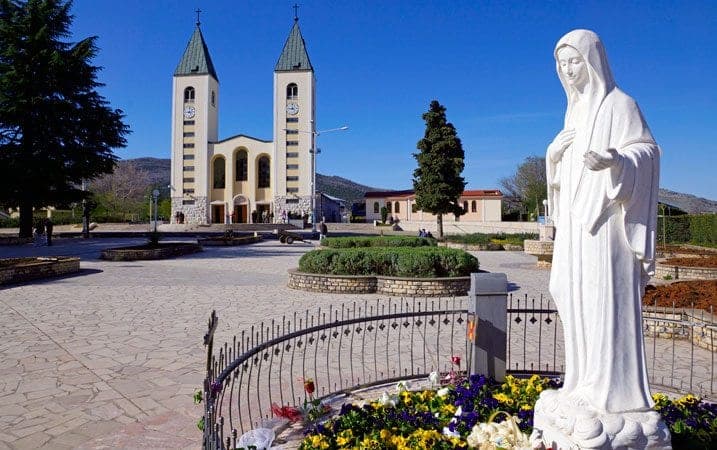ROME— As rumors are once again making the rounds about the Vatican’s stance on the alleged Marian apparitions in the small Bosnia-Herzegovina town of Medjugorje, a Vatican spokesman denied on Monday that any new move is “imminent.”
The statement from Father Federico Lombardi, the Vatican spokesman, came as local newspapers had been reporting that Pope Francis would appoint a special administrator for the site in the next months, presumably a reflection that the Vatican wants to assert more direct control.
The report from Večernji List also said it’s “assumed” that the church currently in the location would become a shrine managed by the papal appointee.
Lombardi said that appointing an administrator “is one of the hypotheses being studied among others, but no decision in this regard has yet been made.”
“It’s premature to speak of this as a path taken or as an imminent decision,” he told reporters on Monday.
Medjugorje, in the former Yugoslavia, became famous in some Catholic circles after 1981, when six local children began talking about seeing visions of the Virgin Mary. Since then, millions have made the pilgrimage to this site.
For several years the six visionaries reported seeing daily apparitions and up to this day, three of the six “seers” claim to still see the Madonna every day. Among other things, this is one of the points highlighted by observers as to why the Vatican has taken so long to address the legitimacy of the alleged apparitions.
When Bernadette Soubirous saw Our Lady of Lourdes in France, in 1858, it took Pope Pius IX four years to allow for the Marian devotion to be venerated, and it rapidly spread throughout the world.
In the case of the Marian apparitions in Fatima, Portugal, it took the Church 13 years to declare them worthy of belief. They occurred during a limited period of time from May 13 to Oct. 13 of 1917.
In general, alleged apparitions are labeled by the Church as “not worthy of belief,” “not contrary to the faith,” or “worthy of belief.” In a 2010 apostolic exhortation, Benedict XVI wrote that the approval of a private revelation basically means that its message “contains nothing contrary to faith and morals.”
The pope emeritus also wrote at the time that “a private revelation can introduce new emphasis, give rise to new forms of piety, or deepen older ones,” but it’s never obligatory for Catholics to incorporate the content of those revelations into their personal spirituality.
The point doesn’t apply only to Marian apparitions, but to other devotions that are the result of a private revelation, such as the Divine Mercy devotion introduced by Polish St. Faustina Kowalksa and promoted by St. Pope John Paul II.
Regarding Medjugorje, in 1991 the local bishops conference- then part of Yugoslavia, now Bosnia-Herzegovina- issued a declaration stating that there are no grounds to believe there are supernatural elements in the claims of apparitions and revelations.
Five years later, then-Archbishop Tarcisio Bertone, Secretary of the Congregation for the Doctrine of the Faith under then-Cardinal Joseph Ratzinger (today Benedict XVI), stated that official pilgrimages to Medjugorje are not allowed, forbidding parishes or dioceses to organize them.
In 2010, at the request of the bishops of Bosnia-Herzegovina, the Vatican established a commission, headed by Italian Cardinal Camillo Ruini, to examine the Medjugorje phenomenon. The work of that body ended in 2014, but their conclusions haven’t been made public.
In general, Vatican officials over the years have expressed a degree of skepticism about the alleged revelations — not merely for their volume, but also because in some cases they challenge the decisions or authority of the local bishop.
Until there’s some indication from the Vatican, officially speaking the 1991 ruling from the local bishops still stands.
On June 2015, on his way back from a day trip to Sarajevo, the capital of Bosnia-Herzegovina, Pope Francis said the Vatican had reached a conclusion, and the Congregation for the Doctrine of the Faith would soon release a set of guidelines for the bishops.
More than a year later, no such document has been released.
Some observers have pointed out that the delay could be related to the fact that, even though the Church sees no supernatural element in the apparitions, the site has become an important pilgrimage site. Popular devotion has continued to grow and many spiritual fruits have occurred there, from inexplicable cures to vocations to the priesthood.
Pope Francis is a strong supporter of what he’s described as “popular religiosity,” which sees millions of pilgrims flocking to shrines every year, to entrust themselves and their loved ones to the Virgin Mary and the saints.
During a Mass he celebrated in January as part of the Holy Year of Mercy, the pope said that such time-honored grassroots devotion is a genuine form of spreading the faith.
“In the shrines, in fact, our people live a deep spirituality, that of the piety that through centuries has reflected the faith with simple, but very meaningful, devotions,” Francis said.
Yet on June 2015, mere days after referring to Medjugorje, he cautioned against basing one’s faith on apparitions or anything other than Christ.
During his daily morning Mass, Francis said that the Virgin Mary “is not postmistress, who sends messages every day” and asked the faithful to understand that “the Kingdom of God is among us” and to stop seeking “strange things.”













